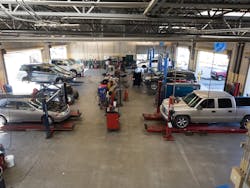One day, Rob Slagle is pitching the automotive trade to kindergarten students during a school job fair. A few months later, his tire dealership is the first in the country to partner with Universal Technical Institute Inc. (UTI) in a new program designed to assign post-secondary students to workplaces for hands-on training.
This is the life of a tire dealer in the 21st century when there’s a critical shortage of automotive technicians.
Slagle’s family owns and operates S&S Tire Co., which includes a three-store retail operation in the Phoenix area that does business as S&S Tire & Auto Service Center. He and his brother, Dan, lead the business, along with Rob’s son, Brad Slagle. They represent the company’s second and third generations.
“I try to be close to my employees and treat them like family,” says Slagle. “Everyone can say that, but we go the extra mile.”
When he visits a store, he always starts in the bays, talking with technicians, from entry-level tire techs to employees with stacks of Automotive Service Excellence (ASE) certifications. He wants to hear from them if they have something to talk about.
“If an employee is short (on cash) one week — maybe the air conditioning unit goes out at home and it’s going to be 115 degrees that week — we loan them the money to get that fixed. Not a lot of organizations can do that. We know we need to meet all the basic needs of our employees.”
That kind of action builds a bond, and Slagle believes it helps the company retain employees. He estimates the average tenure of his employees is at least 10 years.
But a team of long-term employees isn’t enough to protect a tire dealer from the pressure to find, hire and retain automotive technicians.
The hunt for qualified technicians is at the forefront of the industry. The TechForce Foundation says through 2021, there will be an average, annual demand for 75,900 new technicians to enter the workforce.
And that comes as fewer students are entering and completing post-secondary trade programs to join the field.
Vehicles are getting more complex, and fewer vehicle owners are spending their free time as do-it-myself “fixits.”
The TechForce Foundation’s research shows that the strong economy has created more demand for automotive technicians, as well as other transportation-related service industries.
A promising new program
With a business based in Phoenix, Slagle appears to have a built-in advantage in his backyard. The nation’s largest producer of automotive-trained graduates is UTI, and its home base is in Avondale, Ariz. UTI has 12 campuses around the U.S. According to the TechForce Foundation, UTI Arizona had 867 students complete automotive programs in 2017 — 31% more than any other institution.
S&S Tire has employed UTI students for a long time, usually on a part-time basis during the busy summer season. All three of the company’s stores are in the West Valley, and that’s where UTI is, as well. One S&S Tire store is only minutes from the school.
In 2019, UTI picked 10 partners to launch what it called a “first-of-its-kind initiative” to address the talent shortage and skills gap in the automotive industry. S&S Tire was the only tire dealership included in the program.
The Early Employment initiative pairs students with an employer as soon as they start classes at the UTI Arizona campus. The students follow the traditional educational track on campus, but then they add apprenticeship-style, hands-on training at their assigned employers.
Students are paid for their work. Graduates of the program who meet their employers’ criteria can earn reimbursement of school-related expenses and other incentives, plus the promise of a full-time job upon graduation.
UTI says the program’s goal is to help students “graduate and immediately hit the ground running.”
Slagle believes S&S Tire is a good fit for the program because the school specifically wanted to work with a family-owned business that has multiple locations.
The dealership signed a contract with UTI and has promised tuition reimbursement and a toolbox for eligible students. It also has agreed to hire and mentor three students — one at each of its stores — and pay them an hourly rate of $12 to $15 an hour, depending on their experience.
In exchange, S&S Tire wants each student to make a five-year commitment to the tire dealership. The commitment includes the student’s 18 months in school, so it would add up to three-and-a-half years, post-graduation.
At the present moment, S&S Tire’s bays are fully staffed, but Slagle has had a glimpse of what it would be like to be short-staffed. Last year, one of his employees left the company — and the industry. It took nearly three months to fill that position, and in that time, Slagle says losing one technician cost the company “$20,000 to $30,000 in revenue, if not more.”
He’s looking to build a backup team.
“We call it players on the bench,” he says. “If we had an automotive technician leave today, we don’t really have anyone on the bench. We think this program will give us people to sit on the bench.”
Bumps in the road
Of course, being part of a new program means rolling with the punches along the way. Slagle expected his team to interview UTI students at the start of the fall school session and bring those students on board at S&S Tire.
They conducted an initial round of interviews in August and September. Of the dozen-plus students they met, “we didn’t find anybody there that we wanted to put in this program.
“This is a commitment from us,” Slagle says, noting he expects his business’ investment in tools and tuition assistance will cost at least $20,000 for each student.
“I think the program is going to work. We’re still feeling our way through. I think it’s going to be a great resource for us someday.”So what has he learned in the early stages?
The interview process has provided a glimpse of the students’ maturity levels. Some of them are entering UTI straight out of high school. Some move to Phoenix to attend the campus’ flagship campus and they’ve never lived away from home. One interviewee admitted this would be the first job he’s ever held.
The application process might be a hurdle, too. Slagle says after the initial 16 interviews, they narrowed down the field to four or five finalists. At this point, UTI was handling all the paperwork, and S&S Tire wanted to create its own file of these potential employees. It asked finalists to fill out an employment application on the S&S Tire website before the next round of interviews. “Not one of them did that.”
On one hand, it doesn’t seem excessive to ask students to fill out an online application form, he says. But on the other hand, the company doesn’t want something as elementary as that to stand in the way of finding a smart, mechanically inclined employee who could help S&S Tire build its bench of teammates. Slagle understands that these applicants are students first and the company is looking for a solution.
One step has been to appoint a S&S Tire employee as the dealership’s official liaison with UTI.
Employee Jodee Hulsebus has added the post-secondary school program to her workload, which includes managing the tire dealership’s call center, as well as its job applicant tracking and hiring system. Slagle says that will help in the future, especially during that fall recruitment process.
The August interviews coincided with S&S Tire’s second busiest month of the year. Slagle visited UTI again in December and invited a couple of prospective students to come to the company’s headquarters to meet Hulsebus.
“Like anything new that you roll out, you’re going to have to tweak it, improve it and find where the obstacles are,” Slagle says. “We haven’t given up on it. We think there’s value there. We’re going to keep working on it.”
Melanie Scheet, director of national student and employment services for UTI, says the program, which is still in its early stages, was created “hand in hand with our employer partners as a way to deliver more skilled, ready-to-work technicians to the transportation industry. We’re fortunate to work with employers who understand the long-term value that the Early Employment initiative will bring to their workforce and our industry.”
She acknowledges that the demand for automotive technicians is “exceptionally strong,” and says another purpose of the Early Employment program is to help educate students about opportunities that exist in the field, while also highlighting how their employers are committed to them through competitive starting wages, mentorship, tuition reimbursement and other benefits.
Slagle remains committed to the program. “Auto repair is a profitable part of our business,” he says. The mix at the family’s three stores is 60% tires and 40% service, “and that 40% is important and profitable, not just this month or next month, but five years from now.
“In our business, if it’s not on fire or falling off, it doesn’t sometimes get our attention. Without a doubt this is where our technicians are going to come from in the future. They’re not going to come from high schools because most of those programs are gone.”
And that brings us back to kindergarten.
Among the job fairs he attended last year, one was at a local elementary school. His first-period assignment was with five-and six-year-olds. He also talked to sixth, seventh and eighth graders later in the day.
He told the students that technicians used to have dirty jobs in the shop. But it’s not like that anymore. He told them it wasn’t that different from being a doctor or dentist.
“Instead of working on people, you’re working on cars.” ■




